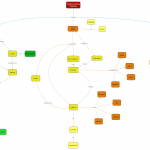Our final task on this issue is to publish our concept map so that it can be compared with the on you developed on the concept page of this blog. Since this map was meant for us to compare the theories no attempt was made to have a single set of common elements. Instead these are shown in yellow in each theory on the map. Click on the image below to view the full map.
 It is only natural for us to try to understand how the theories compare to each other since they all address the same thing in different ways. The table below is an attempt to show how they stack up against each other.
It is only natural for us to try to understand how the theories compare to each other since they all address the same thing in different ways. The table below is an attempt to show how they stack up against each other.
| DIFFERENCES BETWEEN ACTIVITY THEORY, SITUATED ACTION MODELS, AND DISTRIBUTED COGNITION | |||
| ACTIVITY THEORY | SITUATED ACTION | DISTRIBUTED COGNITION | |
| The unit of analysis | an activity | the activity of persons acting in setting | a cognitive system composed of individuals and the artifacts they use |
| Key | the subject | the experience | system goal |
| Establishes Object goals | at the beginning | after the activity | at the beginning |
| The activity is determined | before | in situ | before |
| Objects partially determines activity | yes | no | yes |
| Has behaviouristic qualities | no | yes | no |
| Distinctly identifies one activity from another | yes | no | Yes |
| Persistent structures are a central focus | yes | in special cases | most seriously |
| Considers historical development of activity | yes | no | yes |
| Artifacts mediate activities | yes | no | yes |
| Is routine and predictable | yes | no | no |
| Is emergent, contingent, improvisatory | no | yes | no |
| Emphasizes motive and consciousness | yes | no | no |
| Treats people and things as conceptually equivalent | no | no | yes |
DECIDING AMONG THE THREE APPROACHES (Nardi 1995)
THE ACTIVITY THEORY
The activity theory and distributed cognition are very close in spirit has the richest framework for studies of context in its comprehensiveness and engagement with difficult issues of consciousness, intentionality, and history.
SITUATED ACTION
Situated action provided a much-needed corrective to the rationalistic accounts of human behavior from traditional cognitive science make it difficult to go beyond the particularities of the immediate situation for purposes of generalization and comparison have two key problems:
- they do not account very well for observed regularities and durable, stable phenomena that span individual situations,
- they ignore the subjective.
DISTRIBUTED COGNITION
Distributed cognition has shown how detailed analyses that combine the formal and cognitive properties of artifacts with observations on how artifacts are used can lead to understandings useful for design.
Reference
Nardi, B. A. (1995) Studying Context: A comparison of activity theory, situated action models, and distrubuted cognition. In B. A. Nardi (Ed.) Context and Consciousness: Activity Theory and Human-Computer Interaction (pp. 35-52). Cambridge, MA: MIT Press. Available online at: http://www.ics.uci.edu/~corps/phaseii/nardi-ch4.pdf
